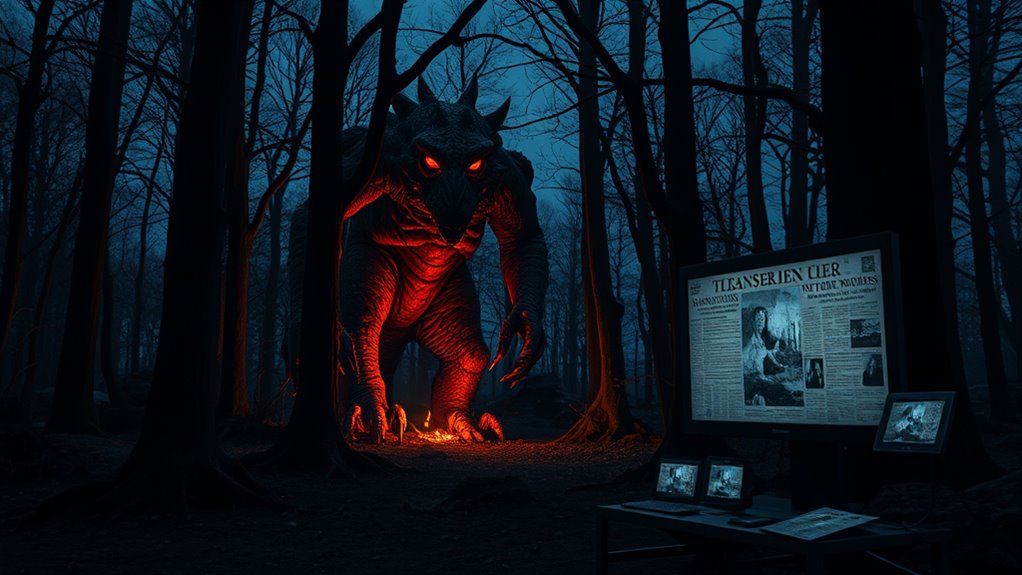Hoaxes and false reports strongly influence your beliefs about monsters, blurring the lines between myth and reality. Cleverly crafted photos, videos, or stories can make you think a creature is real, especially online. These hoaxes often spread myths, foster misconceptions, and even lead to widespread fears. Recognizing signs of deception and understanding how misinformation spreads helps you stay skeptical. If you want to learn how to spot these tricks and protect your beliefs, there’s more to uncover.
Key Takeaways
- Hoaxes can create false narratives that reinforce belief in mythical monsters, impacting public perception.
- Fabricated evidence like photos or videos can deceive audiences and spread misinformation.
- Expert analysis helps distinguish genuine sightings from deliberate hoaxes, reducing false beliefs.
- Repeated hoaxes can perpetuate myths and influence cultural attitudes toward monsters.
- Technological tools improve detection of digital manipulation, aiding in the containment of misinformation.

Throughout history, monsters have captured our imaginations as symbols of fear, mystery, and the unknown. These creatures often become the focal point of stories, legends, and sightings that thrill or terrify us. When you hear about cryptid sightings—claims of strange creatures lurking in remote forests or deep lakes—your first instinct might be to believe or dismiss them. But understanding how hoax detection plays a role in these reports is essential if you want to separate fact from fiction. Many supposed sightings are cleverly crafted hoaxes designed to deceive or entertain, and they can easily influence public perception, making people believe in monsters that aren’t real.
You might wonder how these hoaxes start and why they persist. Sometimes, individuals create fake photographs, videos, or footprints to gain attention or to perpetuate myths. These fabrications can appear convincing, especially when shared widely on social media or forums dedicated to cryptid lore. As someone interested in these stories, you need to develop a keen eye for hoax detection. Recognizing common signs—such as inconsistent shadows, digital artifacts, or unnatural movements—can help you discern whether a cryptid sighting is genuine or fabricated. Understanding the motives behind these hoaxes is also indispensable. Some hoaxers aim for fame, while others might want to sell merchandise or simply enjoy baffling the public.
By applying critical thinking and analyzing the evidence, you can avoid falling for misleading reports. For example, many supposed sightings are later disproven when experts examine the evidence thoroughly. They look for signs of tampering or deliberate deception, which can include doctored images or exaggerated stories. When you approach cryptid sightings with skepticism and demand credible evidence, you help filter out the noise from genuine reports. This process of hoax detection is essential because it keeps misinformation at bay and preserves the integrity of what we know—and what we don’t.
Additionally, technological advances have made it easier to identify digital manipulation, further aiding in hoax detection. The allure of monsters persists because humans are naturally drawn to mystery. The thrill of believing in something beyond our understanding keeps these stories alive, even when most turn out to be hoaxes. Yet, by understanding the techniques behind hoax detection, you empower yourself to enjoy these tales with a healthy dose of skepticism. You can appreciate the cultural significance of monsters and the stories they inspire without falling prey to false claims. In doing so, you strike a balance—respecting the fascination with the unknown while remaining critical of the evidence presented, ensuring your beliefs are rooted in truth rather than fiction.
Frequently Asked Questions
How Do Social Media Algorithms Amplify Hoaxes?
Social media algorithms amplify hoaxes by prioritizing viral content, regardless of its accuracy. When you share or engage with sensational or misleading posts, the algorithmic bias boosts their visibility, making them seem more credible. This cycle encourages the spread of false information because the platform’s design favors engagement over truth. As a result, hoaxes spread rapidly, influencing your beliefs and perceptions without you realizing it.
What Psychological Factors Make People Believe in Monsters?
Like moths drawn to a flame, you’re often captivated by monsters due to cognitive biases such as pattern recognition and confirmation bias. Media influence amplifies these tendencies, making terrifying stories seem real. Your brain seeks certainty in chaos, creating a belief that monsters exist. These psychological factors, combined with sensational media, lure you into accepting frightening tales, even when evidence suggests otherwise.
Can Hoaxes About Monsters Influence Real-World Behavior?
Hoaxes about monsters can definitely influence your real-world behavior. When you encounter cryptid sightings or myth propagation stories, they can trigger fear, curiosity, or even paranoia. These false reports often spread quickly, making you more likely to become involved in hoaxes or share misinformation. By believing in these hoaxes, you might avoid certain areas, alter your daily routines, or participate in activities driven by the myth, impacting your actions profoundly.
How Do Authorities Combat Misinformation About Mythical Creatures?
You might feel intrigued or even frightened by mythical creature rumors, but authorities fight misinformation through myth verification and expert skepticism. They scrutinize claims, analyze evidence, and consult specialists to debunk false stories. By revealing the truth, they protect communities from unnecessary panic and misinformation’s influence. Stay cautious—trust verified facts, and remember that expert skepticism is your best defense against the allure of hoaxes.
What Role Does Folklore Play in Modern Monster Hoaxes?
Folklore plays a key role in modern monster hoaxes by providing a rich backdrop of cryptid sightings and folklore origins that hoaxers can manipulate. You might notice that these stories often draw from traditional tales, making them more believable. By blending real folklore with fabricated evidence, hoax creators tap into existing beliefs, fueling cryptid sightings and reinforcing myths, which can easily spread misinformation and influence public perceptions.
Conclusion
You see how monsters and misinformation blur truth and fantasy, shaping your beliefs in subtle, powerful ways. They feed your fears, fuel your curiosity, and challenge your trust. You must question what you hear, scrutinize what you see, and seek evidence beyond the stories. Because, in the end, understanding the influence of hoaxes helps you discern reality from illusion, empowering you to stand firm against the shadows of misinformation and embrace the clarity of truth.










